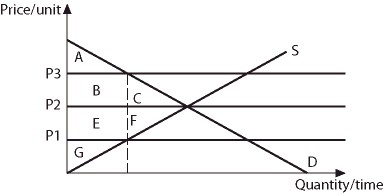Refer to the information provided in Figure 4.6 below to answer the question(s) that follow.Equilibrium in this market occurs at the intersection of curves S and D. Figure 4.6Refer to Figure 4.6. If price goes from equilibrium to P1, consumer surplus changes by the area
Figure 4.6Refer to Figure 4.6. If price goes from equilibrium to P1, consumer surplus changes by the area
A. E + F.
B. E - C.
C. C + E.
D. B - F.
Answer: B
You might also like to view...
In 1935, the U.S. Patent and Trademark Office issued Parker Brothers a trademark on the
use of the name Monopoly for a board game. Hasbro bought Parker Brothers in 1991. Which of the following statements is true regarding the trademark on the name Monopoly for a board game? A) The trademark expired in 1955, 20 years after the trademark was issued to Parker Brothers. B) The original trademark expired well before Hasbro bought Parker Brothers, so they never had a trademark on Monopoly. C) Trademarks never expire, so Hasbro continues to have a trademark on the name Monopoly. D) The trademark expired in 2011, 20 years after Hasbro's purchase of Parker Brothers.
The economic functions of government differ from the political functions of government in that
A) the economic functions are carried out by the federal government, while the political functions are carried out by state and local governments. B) the economic functions include policies that affect income redistribution, while the political functions involve things that affect the way exchange is carried out. C) the economic functions involve things that affect the way exchange is carried out while the political functions include policies that affect income redistribution. D) the economic functions are carried out by state and local governments, while the political functions are carried out by the federal government.
The ideas of economist Arthur Laffer became the centerpiece for tax policy during the:
A. Ford administration. B. Clinton administration. C. Nixon administration. D. Reagan administration.
A market demand curve is
A. upward sloping. B. perfectly inelastic. C. perfectly elastic. D. downward sloping.